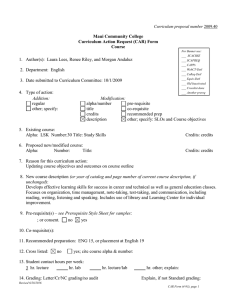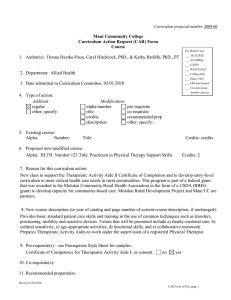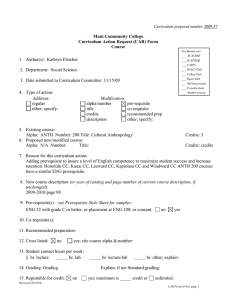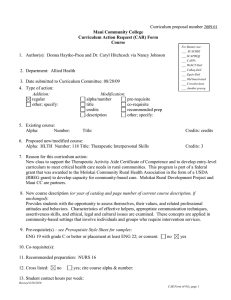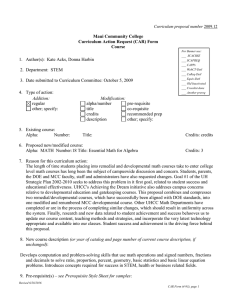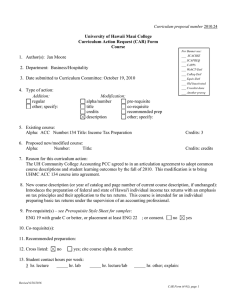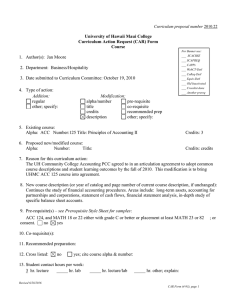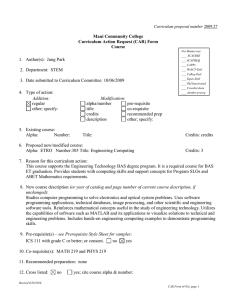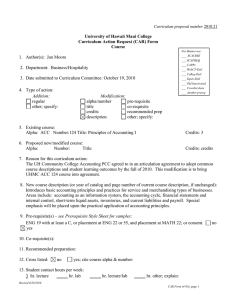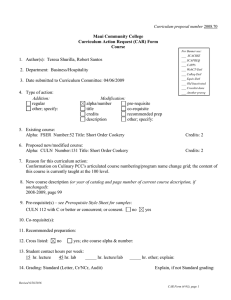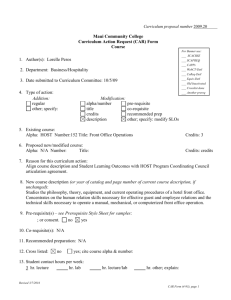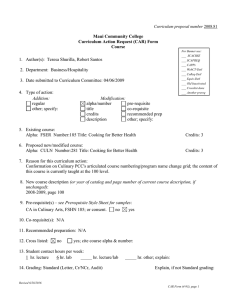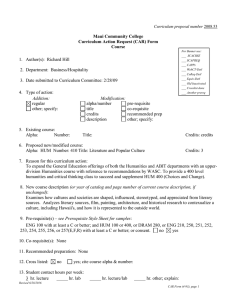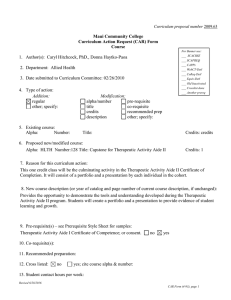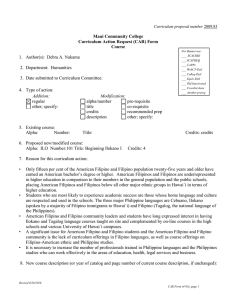Maui Community College Curriculum Action Request (CAR) Form Course
advertisement
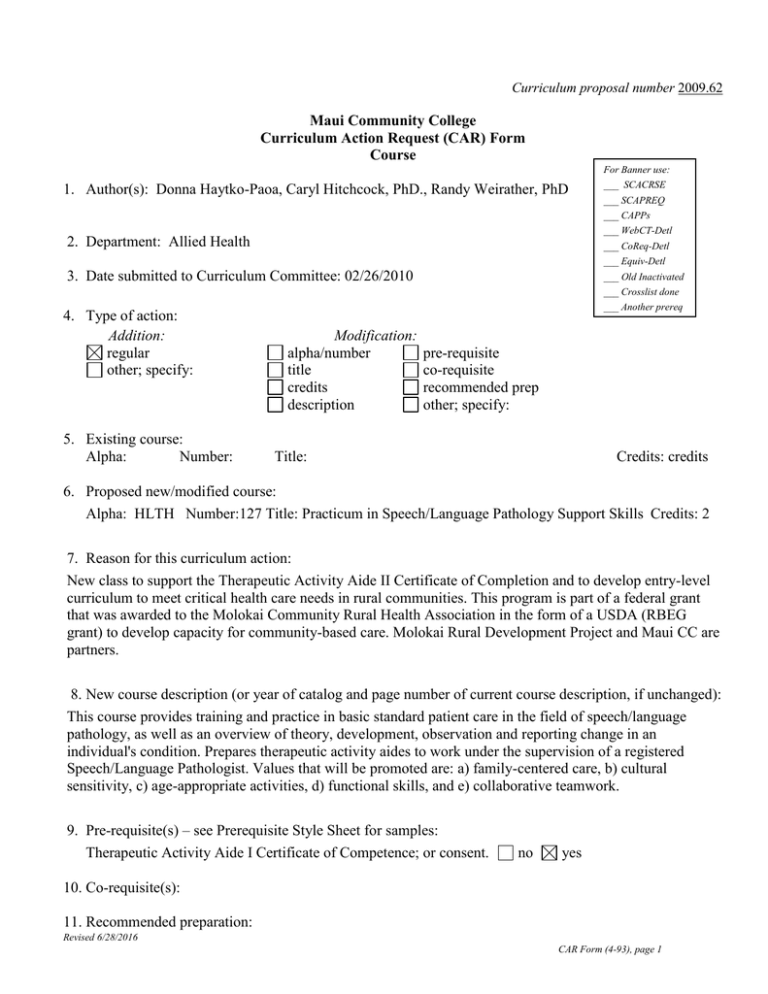
Curriculum proposal number 2009.62 Maui Community College Curriculum Action Request (CAR) Form Course For Banner use: 1. Author(s): Donna Haytko-Paoa, Caryl Hitchcock, PhD., Randy Weirather, PhD ___ SCACRSE ___ SCAPREQ ___ CAPPs ___ WebCT-Detl 2. Department: Allied Health ___ CoReq-Detl ___ Equiv-Detl 3. Date submitted to Curriculum Committee: 02/26/2010 ___ Old Inactivated ___ Crosslist done 4. Type of action: Addition: regular other; specify: 5. Existing course: Alpha: Number: ___ Another prereq Modification: alpha/number title credits description pre-requisite co-requisite recommended prep other; specify: Title: Credits: credits 6. Proposed new/modified course: Alpha: HLTH Number:127 Title: Practicum in Speech/Language Pathology Support Skills Credits: 2 7. Reason for this curriculum action: New class to support the Therapeutic Activity Aide II Certificate of Completion and to develop entry-level curriculum to meet critical health care needs in rural communities. This program is part of a federal grant that was awarded to the Molokai Community Rural Health Association in the form of a USDA (RBEG grant) to develop capacity for community-based care. Molokai Rural Development Project and Maui CC are partners. 8. New course description (or year of catalog and page number of current course description, if unchanged): This course provides training and practice in basic standard patient care in the field of speech/language pathology, as well as an overview of theory, development, observation and reporting change in an individual's condition. Prepares therapeutic activity aides to work under the supervision of a registered Speech/Language Pathologist. Values that will be promoted are: a) family-centered care, b) cultural sensitivity, c) age-appropriate activities, d) functional skills, and e) collaborative teamwork. 9. Pre-requisite(s) – see Prerequisite Style Sheet for samples: Therapeutic Activity Aide I Certificate of Competence; or consent. no yes 10. Co-requisite(s): 11. Recommended preparation: Revised 6/28/2016 CAR Form (4-93), page 1 12. Cross listed: no yes; cite course alpha & number: 13. Student contact hours per week: hr. lecture hr. lab 4 hr. lecture/lab hr. other; explain: 14. Grading: Letter grade only/No Audit Explain, if not Standard grading: Certificate of Completion requires letter grades so that students must earn a GPA of 2.0 or higher in all credit courses to earn the certificate. 15. Repeatable for credit: no yes; maximum is credit or unlimited. (Most courses are not repeatable for additional credit; exceptions are courses such as internships and co-op courses.) 16. Special fees required: no yes; explain: Allied Health course malpractice insurance fee 17. Proposed term of first offering: .Spring semester of 2011 year. 18. List catalog used and then degrees, certificates, prerequisites, and catalog sections and their page numbers affected by this proposal: 22. 28. 114 19. Maximum enrollment: 16 Rationale, if less than 35: Lecture/lab setting requires hands-on learning activities and more intensive supervision. 20. Special resources (personnel, supplies, etc.) required: purchased supplies. no yes; explain: Grant built facility and 21. Course is restricted to particular room type: no yes; explain: lecture/lab setting 22. Special scheduling considerations: no yes; explain: 23. Method(s) of delivery appropriate for this course: (check all that apply) Traditional HITS/Interactive TV Cable TV Online Other, explain: Hybrid 24. Mark all college-wide general education SLOs this course supports. Std 1 - Written Communications Std 2 – Quantitative Reasoning Std 3 - Information Retrieval and Technology Std 4 - Oral Communication Std 5 - Critical Reasoning Std 6 – Creativity Other General Education SLOs, such as Ethics, Scientific Inquiry, or Service Learning. Explain: 25. List all program SLOs this course supports? (Explain, if necessary) Program SLO 1: Program SLO 2: Program SLO 3: Program SLO 4: Explain: Explain: Explain: Explain: Revised 6/28/2016 CAR Form (4-93), page 2 Program SLO 5: 26. Explain: Course fulfills the following general education elective (GE) for CTE (Career Technical Education) AS/AAS degrees (GE): English (EN)/Communication (CM) Quantitative Reasoning (QR) Humanities (HU) Natural Science (NS) Social Science (SS) Other: Course is a requirement for the program(s) AS/AAS degree or certificate Course is a program elective for the program(s) AS/AAS degree or certificate 27. Course fulfills the following general education elective (GE) for the ABIT BAS degree: English (EN)/Communication (CM) Quantitative Reasoning (QR) Humanities (HU) Natural Science (NS) Social Science (SS) Other: Course is a requirement for the ABIT BAS degree Course is a program elective for the ABIT BAS degree 28. Course fulfills a requirement for a proposed BAS degree: Pre- requisite course Core Capstone Course (CC) Other: Course is a program elective for a proposed BAS degree Course fulfills the following general education elective (GE) for the proposed BAS English (EN)/Communication (CM) Quantitative Reasoning (QR) Humanities (HU) Natural Science (NS) Social Science (SS) Other: Course is applicable to the following additional BAS degrees: 29. degree: Course satisfies the following category for the AA degree*: Category I: Foundations/Skills: Foundations I Written Communication in English (FW) Global and Multicultural Perspectives (FG) Group A (before 1500 CE) Group B (since 1500 CE) Group C (pre-history to present) Symbolic Reasoning (FS) Category I: Foundations/Skills: Foundations II Numeracy (FN) Oral Communication in English (FO) Computer/Information Processing and Retrieval (FI) Category II: Breadth of Understanding and Experience Human Understanding The Individual (IN) The Community (CO) The Community – Global Perspective (CG) Human Expression (HE) Environmental Awareness (EA) Revised 6/28/2016 CAR Form (4-93), page 3 Environmental Awareness – Global Perspective (EG) Asia/Pacific Perspective (AP) Category III Focus/Specialization/Area of Interest Interest Area Discipline/Alpha: Elective (LE) Other Graduation Requirements Writing Intensive (is appropriate for WI) Environmental Awareness Lab/course with lab (EL) Hawaii Emphasis (HI) * Submit the appropriate form(s) to have the course placed in the requested category (ies). Submit a course outline, CAR, and appropriate forms to both the Curriculum Committee and the Foundations Board, if the course satisfies Category I: Foundations/Skills: Foundations I or II. 30. Course increases decreases makes no change to number of credits required for program(s) affected by this action. Explain, if necessary: 31. Course is taught at another UH campus (see Sections 5 and 6 above): no Explain why this course is proposed for MCC: yes Specify college(s), course, alpha, and number where same or similar course is taught: 32. Course is: Not appropriate for articulation. Appropriate* for articulation as a general education course at: UHCC UH Manoa UH Hilo UHWO Previously articulated* as a general education course at: UHCC UH Manoa UH Hilo UHWO *Note: Submit Course Articulation Form if course is already articulated, or is appropriate for articulation, as a general education (100-, 200-level) course. Standardized and/or appropriate for articulation by PCC or other UH system agreement at: UHCC UH Manoa UH Hilo UHWO Explain: Appropriate for articulation or has previously been articulated to a specific department or institution: UHCC UH Manoa UH Hilo UHWO Outside UH system Explain: 33. Additional Information (add additional pages if needed): Revised 6/28/2016 CAR Form (4-93), page 4 Maui Community College Curriculum Action Request (CAR) Signature Page __________________________________________________________________________ Proposed by: Author or Program Coordinator Date __________________________________________________________________________ Checked by: Academic Subject Area Representative to Curriculum Committee Date __________________________________________________________________________ Requested by Department: Department Chair Date __________________________________________________________________________ Recommended by: Curriculum Chair Date __________________________________________________________________________ Approved by Academic Senate: Academic Senate Chair Date __________________________________________________________________________ Endorsed by: Chief Academic Officer Date __________________________________________________________________________ Approved by: Chancellor Date Revised 6/28/2016 CAR Form (4-93), page 5 Maui Community College Course Outline 1. Alpha HLTH Number 127 Course Title Practicum in Speech/Language Pathology Support Skills Credits 2 Department Allied Health Author Donna Haytko-Paoa, Caryl Hitchcock, PhD., Randy Weirather, PhD Date of Outline 02/26/2010 2. Course Description: Effective Date Spring 2011 5-year Review Date 2016 This course provides training and practice in basic standard patient care in the field of speech/language pathology, as well as an overview of theory, development, observation and reporting change in an individual's condition. Prepares therapeutic activity aides to work under the supervision of a registered Speech/Language Pathologist. Values that will be promoted are: a) family-centered care, b) cultural sensitivity, c) age-appropriate activities, d) functional skills, and e) collaborative teamwork. . Cross-list Contact Hours/Type 3. Pre-requisites 4 hours lecture/lab Therapeutic Activity Aide I Certificate of Competence Pre-requisite may be waived by consent yes no Co-requisites Recommended Preparation 4. Function/Designation AS Program AA LE - Elective Category Additional Category List Additional Programs and Category: AAS Program Category List Additional Programs and Category: BAS Program Category List Additional Programs and Category: Developmental/Remedial Other/Additional: Explain: Therapeutic Activity Aide II Certificate of Completion Revised 6/28/2016 CAR Form (4-93), page 6 See Curriculum Action Request (CAR) form for the college-wide general education student learning outcomes (SLOs) and/or the program learning outcomes (PLOs) this course supports. This course outline is standardized and/or the result of a community college or system-wide agreement. Responsible committee: 5. Student Learning Outcomes (SLOs): List one to four inclusive SLOs. For assessment, link these to #7 Recommended Course Content, and #9 Recommended Course Requirements & Evaluation. Use roman numerals (I., II., III.) to designate SLOs On successful completion of this course, students will be able to: I. Demonstrates the ability to follow a plan of care and work under the supervision of a registered Speech/Language Patholgist. II. III. IV. 6. Competencies/Concepts/Issues/Skills For assessment, link these to #7 Recommended Course Content, and #9 Recommended Course Requirements & Evaluation. Use lower case letters (a., b.…zz. )to designate competencies/skills/issues On successful completion of this course, students will be able to: a) Learn, following a plan of care, the skills and procedures appropriate for the role of Therapeutic Activity Aide utilizing accepted standards of care from the American Speech-Language-Hearing Association (ASHA). b) Become familiar with normal developmental data in the areas of preverbal cognitive skills, grammar, semantics, pragmatics, phonology, narratives, metacognition, reading, writing, and math, and swallowing, as they occur from birth through adolescence. c) Become familiar with major theories of language acquisition and learning strategies. d) Become familiar with assessment and development of therapeutic interventions for individuals with speech language delays/disorders such as phonological, fluency, voice, motor-speech (apraxia & dysarthria), feeding & swallowing disorders, as well as hearing loss e) Follow a plan of care and report concerns or changes in an individual's health or functional status to a licensed professional. f) Practice appropriate intervention activities, strategies and techniques in the communication areas of speech, language and hearing to meet the needs of the client. g) Develop a multicultural focus as reflected in language development, especially with attention to language differences likely to be encountered within Hawaii and the Pacific Basin. h) Utilize critical thinking in classroom activities and in assignments outside of class. 7. Suggested Course Content and Approximate Time Spent on Each Topic Linked to #5. Student Learning Outcomes and # 6 Competencies/Skills/Issues TOPICS/ACTIVITIES Revised 6/28/2016 CAR Form (4-93), page 7 2-3 Weeks Foundations of Communication and Disorders (I, a-h) a. History and ethical practices reflecting ASHA guidelines b. Overview of Communication Development c. Anatomy & Physiology of Communication and Communication Disorders 2-3 Weeks Communication Assessment and Intervention: Principles and Practices (I, a-h) a. Assessment types, purpose and relation to intervention planning b. Augmentative, Alternative and Complex Communciation Needs 3-4 Weeks. Communication Disorders across the lifespan (I, a-h) Characteristics of child and adult communication disorders, including those asociated with: a. Phonological Disorders Fluency Disorders Voice Aphasia Traumatic Brain Injury Stroke Motor-Speech (Apraxia & Dysarthria) b. Hearing loss c. Feeding and Swallowing d. Literacy development in the school age years e. Dementia 2-3 Weeks Implementing S/L interventions identified in the plan of care (I, a-h) a. Speech b. Language c. Hearing d. Feeding & Swallowing e. Other current therapies 2 - 3 Weeks Application of speech/language therapy skills through the teaching/learning process (I, a-h) a. Observations b. Case Studies 8. Text and Materials, Reference Materials, and Auxiliary Materials Appropriate text(s) and materials will be chosen at the time the course is offered from those currently available in the field. Examples include: Shulman, B. B., & Capone, N. C. (2010). Language Development: Foundations, Processes, and Clinical Applications. Sudbury, Massachusetts: Jones & Bartlett Publishers Justice, L. (2010). Communication Sciences and Disorders: An Introduction 2nd edition. Pearson Revised 6/28/2016 CAR Form (4-93), page 8 Appropriate reference materials will be chosen at the time the course is offered from those currently available in the field. Examples include: Magazines, Journals, Websites and other peer-reviewed, evidence-based media appropriate to the course Appropriate auxiliary materials will be chosen at the time the course is offered from those currently available in the field. Examples include: 9. Suggested Course Requirements and Evaluation Linked to #5. Student Learning Outcomes (SLOs) and #6 Competencies/Skills/Issues Specific course requirements are at the discretion of the instructor at the time the course is being offered. Suggested requirements might include, but are not limited to: Activities (I, a-h) Assignments (I, a-h) Projects/Presentations (I, a-h) Other appropriate assessment methods (I, a-h) 50 - 70% 10 - 30% 20 - 30% 0 - 30% 10. Methods of Instruction Instructional methods will vary considerably by instructor. Specific methods are at the discretion of the instructor teaching the course and might include, but are not limited to: Lectures and demonstrations, group discussions, student participation, role play, projects, field trips, and other appropriate emerging modalities 11. Assessment of Intended Student Learning Outcomes Standards Grid attached 12. Additional Information: Assessment of Intended Student Learning Outcomes Standards – CCOWIQs with Ratings for HLTH 127 Key: 3 = Major Emphasis: The student is actively involved (uses, reinforces, applies, and evaluated) in the student learning outcomes. The learner outcome is the focus of the class. 2 = Moderate Emphasis: The student uses, reinforces, applies and is evaluated by this learner outcome, but it is not the focus of the class 1 = Minor Emphasis: The student is provided an opportunity to use, reinforce, and apply this learner outcome, but does not get evaluated on this learner outcome 0 = No Emphasis: The student does not address this learner outcome Standard 1: Written Communication Write effectively to convey ideas that meet the needs of specific audiences and purposes. 1. Use writing to discover and articulate ideas 1.2 Identify and analyze the audience and purpose for any intended communication 1.3 Choose language, style and organization appropriate to particular purposes and audiences 1.4 Gather information and document sources appropriately 1.5 Express a main idea as a thesis, hypothesis, and other appropriate content 1.6 Develop a main idea clearly and concisely with appropriate content 1.7 Demonstrate mastery of the conventions of writing, including grammar, spelling, and mechanics 1.8 Demonstrate proficiency in revision and editing HLTH 127 1 2 1 2 1 1 1 1 Revised 6/28/2016 CAR Form (4-93), page 9 1.9 Develop a personal voice in written communication Standard 2: Quantitative Reasoning Synthesize and articulate information using appropriate mathematical methods to solve problems and logically address real-life situations. 2.1 Apply numeric, graphic and symbolic skills and other forms of quantitative reasoning, accurately and appropriately 2.2 Demonstrate mastery of mathematical concepts, skills, and applications, using technology when appropriate 2.3 Communicate clearly and concisely the methods and results of quantitative problem solving 2.4 Formulate and test hypotheses using numerical experimentation 2.5 Define quantitative issues and problems, gather relevant information, analyze that information, and present results 2.6 Assess the validity of statistical conclusions Standard 3: Information Retrieval and Technology (Information Literacy) Access, evaluate, and utilize information effectively, ethically and responsibly. 3.1 Use print and electronic information technology ethically and responsibly 3.2 Demonstrate knowledge of basic vocabulary, concepts, and operations of information technology and retrieval 3.3 Recognize, identify, and define an information need 3.4 Access and retrieve information through print and electronic media, evaluating the accuracy and authenticity of that information 3.5 Create, manage, organize, and communicate information through electronic media 3.6 Recognize changing technologies and make informed choices about their appropriateness and use. Standard 4: Oral Communication Practice ethical and responsible oral communications appropriate to a variety of audiences and purposes. 4.1 Identify and analyze the audience and purpose of any intended communication. 4.2 Gather, evaluate, select, and organize information for the communication. 4.3 Use language, techniques, and strategies appropriate to the audience and occasion. 4.4 Speak clearly and confidently, using the voice, volume, tone, and articulation appropriate to the audience and occasion 4.5 Summarize, analyze, and evaluate oral communications and ask coherent questions as needed. 4.6 Use competent oral expression to initiate and sustain discussion. Standard 5: Critical Thinking Apply critical reasoning skills to effectively address the challenges and solve problems. 5.1 Identify and state problems, issues, arguments, and questions contained in a body of information. 5.2 Identify and analyze assumptions and underlying points of view relating to an issue or problem. 5.3 Formulate research questions that require descriptive and explanatory analyses. 5.4 Recognize and understand multiple modes of inquiry, including investigative methods based on observation and analysis. 5.5 Evaluate a problem, distinguishing between relevant and irrelevant facts, opinions, assumptions, issues, values, and biases through the use of appropriate evidence. 5.6 Apply problem-solving techniques and skills, including the rules of logic and logical sequence. 5.7 Synthesize inform from various sources, drawing appropriate conclusions. 5.8 Communicate clearly and concisely the methods and results of logical reasoning. 5.9 Reflect upon and evaluate their thought processes, value system, and world views in comparison to those of others. Standard 6: Creativity Able to express originality through a variety of forms. 6.1 Generates responses to problems and challenges through intuition and non-linear thinking. 6.2 Explores diverse approaches to solving a problem or addressing a challenge. 6.3 Sustains engagement in activities without a preconceived purpose. 6.4 Demonstrates the ability to trust and follow one’s instincts in the absence of external direction. 6.5 Applies creative principles to discover and express new ideas. 6.6 Builds upon or adapts the ideas of others to create novel expressions or new solutions. 1 1 0 1 0 0 1 2 1 2 2 1 1 2 2 2 3 2 2 2 2 0 2 2 1 2 1 2 1 2 1 1 1 2 Revised 6/28/2016 CAR Form (4-93), page 10
